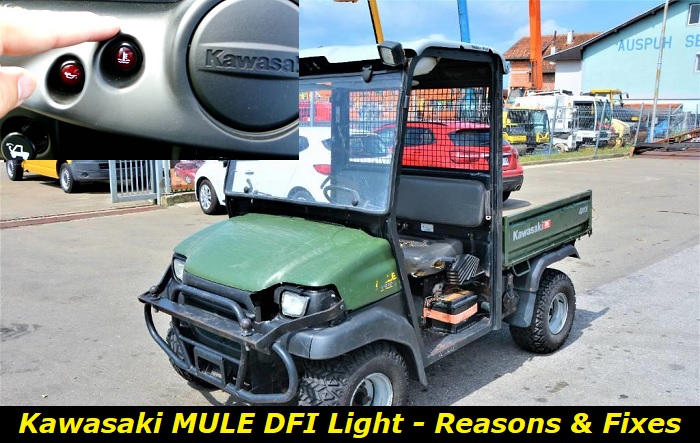Owners of any Kawasaki MULE (Multi-Use Light Equipment) rely on their tiny but powerful machines to perform various demanding tasks. The MULEs have secured owners' trust in various industries due to the dogged resilience that makes them perform efficiently daily.
If your trusted, tried, and true Kawasaki Mule is suddenly displaying the DFI (Digital Fuel Injection) Light, you have every right to be concerned. What does the light indicate? Is it a serious problem? What should you do about it?

This article will take you through everything you need to know about the DFI light that is displayed on your Kawasaki MULE. We will take you through the following:
- How the DFI System Operates
- Common Causes of the 'DFI Light'
- Solutions to 'DFI Light'
- How to Avoid 'DFI Light'
How Does Your Kawasaki Mule DFI System Operate
Your Kawasaki MULE's DFI system has been fine-tuned for a period of over 20 years. It won over consumers because it is simple, reliable, economical, environmentally friendly, and easy to maintain nature. The DFI system relies on an ECU that coordinates the speed, pressure, and temperature.
The Kawasaki MULE's DFI system relies on your ignition coil and three sensors to provide the exact amount of fuel needed. This ingenious system does not need a crank position sensor, throttle position sensor, or oxygen sensor to operate efficiently. Here is a simplified version of how your Kawasaki MULE single grounded open-loop system operates:
- The fuel pump is activated when you turn the key in the ignition. Your Kawasaki MULE's ECU will use the vacuum pressure sensor to read and store the atmospheric pressure value.
- Your ECU then uses a voltage spike from each of your ignition coils to calculate your rpm and crankshaft position related to your pistons. Your Kawasaki MULE's ignition coils are not controlled by ECU.
- The atmospheric pressure settings from your vacuum pressure sensor are monitored continuously, provided the engine is running or cranking.
- The electric fuel pump becomes active after you switch on your Kawasaki MULE. It operates continuously for as long as your engine is running or cranking. A failsafe mechanism turns off the fuel pump if your MULE's engine does not crank for about three seconds. Your ECU passively controls the fuel pump by relying on your fuel pump relay.
- Your Kawasaki MULE's pressure regulator is mechanical. It responds to variations in the intake manifold pressure to ensure the fuel injectors receive fuel at optimal pressure despite the levels in the intake manifold. This is achieved by changing your fuel flow's resistance from the regulator to the tank. When the vacuum in your intake manifold increases, there will be a corresponding decrease in fuel pressure.
- The coolant temperature sensor indicates the engine's temperature, which the ECU regulates accordingly. Where the engine is too cold, the ECU will use a dense mixture, and where it is warm, the ECU will use a lean mixture. You can think of your coolant temperature sensor doing the same job a choke does in a carbureted engine.
- Your fuel injectors rely on the ground connection for efficient operation. When your engine cranks or runs, the ECU will determine when to ground your fuel injector solenoid intermittently.
- Your ECU then relies on the information received from the sensors to determine how much fuel your Kawasaki MULE needs. It energizes your fuel injector solenoids and grounds your control terminal at the right time and for the optimal duration.
- If your ECU detects a malfunctioning circuit, your DFI light will likely display.
Common Causes of DFI Light On in Kawasaki MULE
Now that you are familiar with the operation of your Kawasaki MULE's DFI system locating the warning light's cause will be much easier. Owners have reported that their MULE's DFI lights would turn for some of these reasons:
1. Defective Fuel Filter or Pump
Your fuel pump is a hard-working engine component that can last the shelf life of your Kawasaki MULE if maintained and serviced as recommended in the owner's manual. Unfortunately, some MULE owners, especially the 4010 model, have reported that their fuel pumps begin to malfunction before eventually quitting. No design flaw has been detected, and the most likely cause of poor maintenance.
Usually, fuel pump malfunction is caused by dirt and debris that clogs the fuel filter and pump. Fuel filters are vital to lubricating and cooling the motor and fuel pump. Whether the filters are clogged and not letting enough oil through or are letting through dirty fuel, your fuel pump will pay the price. An insufficient or contaminated fuel supply can wreak havoc on your fuel pump. Should the lubricant and coolant in your Kawasaki MULE run out, and your fuel pump is guaranteed to die in five minutes?
Solution
If you suspect a defective fuel pump or filter may be the culprit behind your troubling DFI light, it is advisable to take it to the dealership, especially if it is still under warranty. You can also search for a reliable auto repair shop or mechanic with experience repairing ATVs and UTVs. Repair experts will inspect the entire system and try cheap fixes, like cleaning the fuel filter and replacing the oil to turn the DFI light off.
Cleaning the fuel filter and changing the fuel are simple tasks. Most owners can perform routine maintenance tasks at home before bringing in professionals. It may save you enough to buy your Kawasaki MULE something it's been begging for a while, like a heat shield.
If you notice that your wire harness is loose or faulty, you replace it or attempt to repair it. Repairing is quite easy. You only need to pull the connector apart and put pressure on the male pins b pressing the female pins against them with a screwdriver or pick.
If cleaning the filter, changing the fuel, and inspecting the harness does not solve your problem, you will need to replace the filter and (or) the pump. In most cases, replacing the two components as a set is advisable to increase their lifespan and efficiency. Ensure you purchase high-quality OEM parts or compatible aftermarket alternatives.
2. Malfunctioning Throttle Body or Sensor
Though owners of the Kawasaki MULE hate to complain about their trusted machines, they have not been shy to highlight the throttle body and sensor problems plaguing various models. They noticed that the crankcase vents directly into the air intake and not the atmosphere due to Environmental Protection Agency regulations.
The oil vapors penetrate the vent system and are sucked into your MULE's engine, where they get burnt off. The residue is a gummy substance that affects your throttle body's optimal functioning. Incorrect valve intake could also cause a carbon (soot) buildup that worsens the vapor's residue.
Solution
Some MULE owners have no option but to replace the throttle body and the throttle position sensor. It does not matter that only one component is defective. The throttle body and sensor are available as a combined assembly unit. In some models, the two components are not preassembled, and owners can replace a defective sensor without purchasing a throttle body and vice versa.
The good news is that It may not get to that. If the throttle body problems causing your DFI light to turn on have not been going on for a long period, try this. Remove your inlet hoe and spray throttle body cleaner in your throttle body while running the engine. This may remove the gummy substance from the surface before it accumulates and demands a replacement.
If your warranty is still in effect, your dealership will fix this common MULE defect free of charge.
3. Contaminated or Substandard Fuel
Is your Mule suddenly struggling to make it up a hill even when using low gear? If your Kawasaki MULE's engine has changed and lost the punch it once had, your DFI light may come on. Owners suffering from this problem will likely notice a loss of general performance and accelerating power.
As most owners rely on their mules to tow and haul significant weights, the problem has to be solved immediately after it manifests. They reported that the problem persisted even after they confirmed their spark; fuel pumps and lines were functioning optimally.
Solution
Contaminated fuel always costs more in engine trouble than the initial savings are worth. The fuel will affect your fuel filter and cause your fuel pump to malfunction. This malfunction is caused by the additional strain the pump faces to supply the little fuel that makes it through your clogged filter. Owners facing this problem are advised to invest in a higher quality fuel. Alternatively, they could use an octane booster.
Conclusion
Your DFI system is simple yet efficient. Figuring out the cause of the warning light is not that complicated because there are very few suspects, to begin with. Once you find and solve the cause of your displaying DFI light, practice the service and maintenance schedule recommended in your manual to avoid further complications.
About the authors
The CarAraC research team is composed of seasoned auto mechanics and automotive industry professionals, including individuals with advanced degrees and certifications in their field. Our team members boast prestigious credentials, reflecting their extensive knowledge and skills. These qualifications include: IMI: Institute of the Motor Industry, ASE-Certified Master Automobile Technicians; Coventry University, Graduate of MA in Automotive Journalism; Politecnico di Torino, Italy, MS Automotive Engineering; Ss. Cyril and Methodius University in Skopje, Mechanical University in Skopje; TOC Automotive College; DHA Suffa University, Department of Mechanical Engineering






Add comment